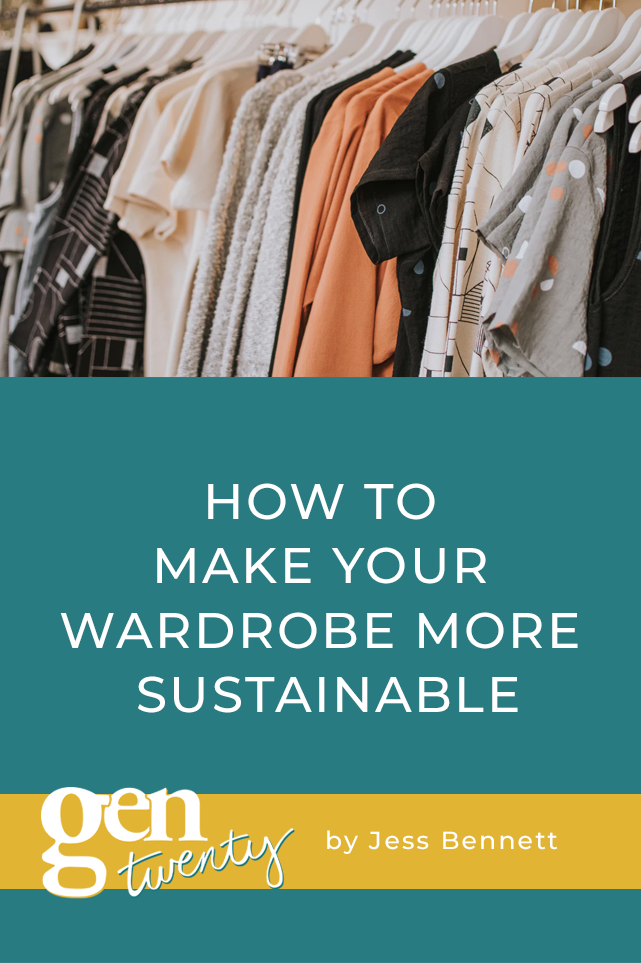
If you care about the planet (as everyone should), you probably know not to litter and to recycle your cardboard boxes. You might bring a reusable water bottle instead of a plastic one to the gym. You might even ask for no straw in your drink at restaurants. But have you ever considered how sustainable your wardrobe is?
The apparel industry takes an enormous toll on the environment. In fact, manufacturing clothes and shoes accounts for over 8 percent of the global climate impact, producing 1.2 billion tons of greenhouse gas emissions each year. To make matters worse, about 85 percent of textiles end up in landfills when most could be reused or recycled.
Clothing waste is a huge problem, and if you wear clothes or shoes, you’re contributing to it. But that doesn’t mean you can’t help change things. Use these tips to give your closet an eco-friendly makeover and start dressing more sustainably.
How to Make Your Wardrobe More Sustainable
1. Reconsider how often you shop.
A sustainable wardrobe starts with your shopping habits. If you’re constantly buying new items when you already have a closet full of clothes, your clothing consumption is way higher than necessary.
Try to cut back on your clothing purchases a little bit each month by only shopping for things you truly need. Your already overflowing closet (and your bank account) will thank you!
2. Invest in clothing that will last.
While striving for a more sustainable wardrobe, incorporating high-quality, timeless pieces is pivotal. For men looking to upgrade their style sustainably, professional advice on selecting enduring styles can be valuable. This consideration aligns seamlessly with the principle of investing in clothing that outlasts trends, reducing waste and promoting eco-friendliness in fashion. To explore how to integrate classic menswear essentials into your wardrobe sustainably, finding style advice on The Modest Man is the perfect starting point.
Ditch “fast fashion” for investment pieces that you can wear over and over again. When you invest it quality clothing, it will hold up better to wear and tear, AND you’ll be less likely to discard it after one season.
For instance, boots have long been considered a fashion staple. We wear them almost all year round during the rainy and winter seasons. For shoes to last long and withstand the elements, investing in a pair like Maison Margiela boots, will not only save you money in the long haul for its durability, but you also stay in style because of its timeless design.
3. Donate your old clothing.
Instead of tossing those jeans that no longer fit, let them be used and loved by someone else—someone who may really need the help.
Organizations like Dress for Success, Goodwill, the American Red Cross, the Salvation Army, and Big Brothers Big Sisters collect clothing in good condition to help individuals and families in need. Local churches, community centers, and homeless shelters also often accept clothing donations. Ask around your community to see how your clothes can do some good locally.
4. Shop secondhand stores.
Think of thrifting as giving clothes a new life. Hit your local thrift stores or shop sites like Poshmark and thredUP to find vintage gems—often for a great price!
5. Resell clothing items in great condition.
Make a little extra cash by selling your clothes to local consignment shops or online using websites like eBay, Craigslist, Facebook Marketplace, and other resale platforms.
6. Repair damaged garments instead of throwing them away.
Whether it’s a sweater with a hole in the sleeve or a jacket with a broken zipper, clothing is usually fixable. Don’t trust yourself with a sewing kit? Take it to a tailor (or a family member who can sew) to get the item fixed and back into your outfit rotation.
7. Choose clothing made from natural materials.
Although manufactured textiles like spandex, nylon, and polyester will break down eventually, that process could take hundreds of years.
Cotton, linen, wool, and silk are all biodegradable fabrics that will break down more quickly. Plus, they can even be composted!
8. Recycle textiles that are past their prime.
Clothes that can’t (or shouldn’t) be reworn by someone else can be recycled and repurposed instead. Recycled textiles are used to create things like home insulation, car seat padding, and “new” fabric made from recycled fibers.
If you’re not sure where to drop off your items, websites like Recycle Now can help you find the nearest recycling point.
9. Participate in garment collection programs.
Many retailers have recently launched recycling programs that reward you with discounts or store credit for turning in your old clothes. H&M, Patagonia, The North Face, Madewell, and Levi’s are just a few brands with these donation programs.
Simply drop unwanted clothing off at in-store donation bins and they’ll handle recycling or repurposing it for you. So the next time you shop for new clothes, the least you can do is recycle your old ones first.
Caring for the environment is everyone’s responsibility, and you can start with a more sustainable wardrobe. When you rethink your shopping habits, donate or resell what you can, and recycle what you can’t, you can make a real difference in how your clothing impacts the environment.
